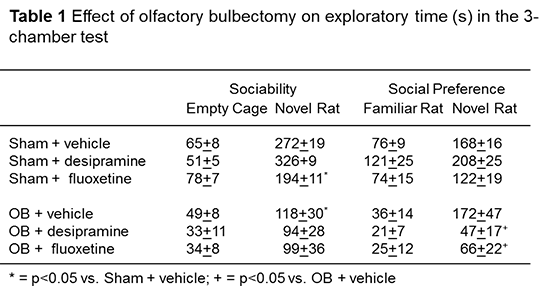| 195P London, UK Pharmacology 2016 |
An assessment of social cognition in the olfactory bulbectomized rat model of depression
Introduction: Social cognitive deficits manifest in an array of psychiatric disorders including depression, and modelling such deficits in laboratory animals is increasingly being studied. The olfactory bulbectomized (OB) rat model of depression has a number of behavioural deficits but social cognition has yet to be examined. The aim of this study was to assess social cognition (using the 3-chamber sociability test) in the OB model and to determine whether chronic antidepressant treatment (with desipramine or fluoxetine) has any effects in this model.
Methods: Male Sprague-Dawley rats (200-250g) were singly-housed and underwent sham or OB surgery using isoflurane anaesthesia. Following two weeks recovery, sham and OB rats were divided into six groups (n=8/group) that received daily subcutaneous injections of vehicle (saline), desipramine or fluoxetine (10mg/kg) for two weeks. Rats were then exposed to the 3-chamber sociability test. This consisted of three consecutive ten-minute time-trials; the habituation trial (empty arena), sociability trial (novel conspecific rat vs. empty cage) and social preference trial (now familiar vs. novel conspecific). Time spent interacting was scored manually, by an observer blind to treatment. Locomotor-activity was recorded using Ethovision® software and the degree of habituation was calculated by expressing distance moved on the 3rd trial as a percentage of the 1st trial. Data are presented as mean±SEM (n=8) exploratory time (s) and analysed using two-way ANOVA, followed where appropriate by post-hoc Student Newman-Keuls test; p<0.05 was deemed statistically significant.
Results: In the sociability trial, OB vehicle (and fluoxetine-treated sham-operated) groups spent significantly less time interacting with the novel conspecific than the sham vehicle group, with no effect of either antidepressant on the reduced interaction in OB animals (Table1). In the social preference trial, although OB vehicle rats did not differ from sham-operated animals, there was a significant reduction in exploratory time spent with the novel rat in both antidepressant-treated OB groups. A significant locomotor habituation to the apparatus was evident in the OB vehicle group (and desipramine sham-operated group), which was not affected by antidepressant treatment.

Conclusion: Removal of the olfactory bulbs causes a pronounced alteration in sociability in rats, as well as a marked habituation to the test arena not seen with sham-operated controls. Such changes were not attenuated by antidepressant treatment, raising the question as to whether these deficits result from olfactory alterations per se, or represent a more widespread neurobiological alteration.
Acknowledgement: Strategic Partnership Programme Grant from Science Foundation Ireland and Alkermes Inc (14/SPP/B3051).

